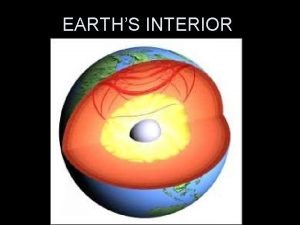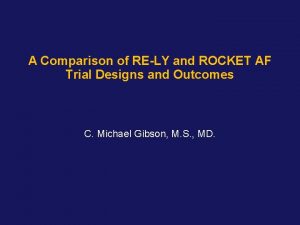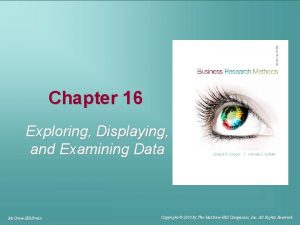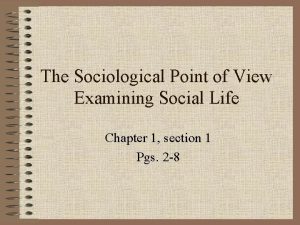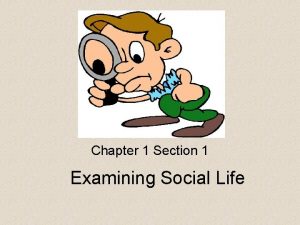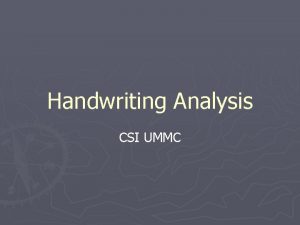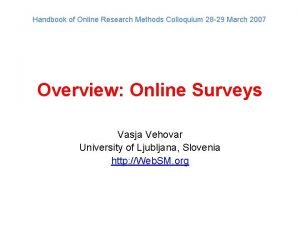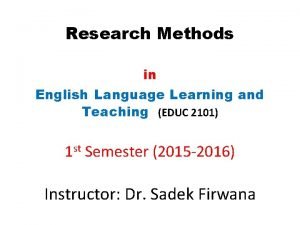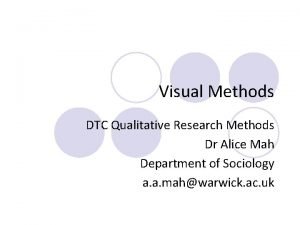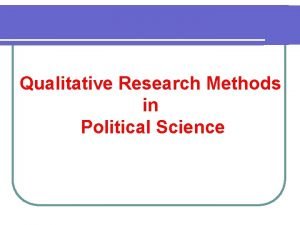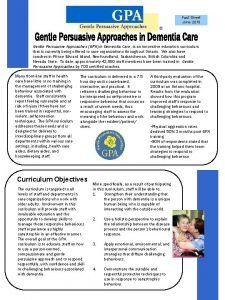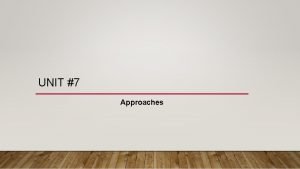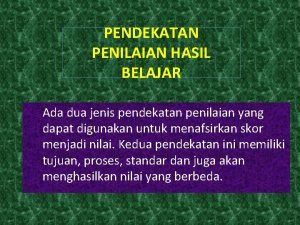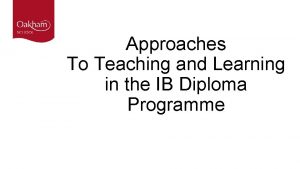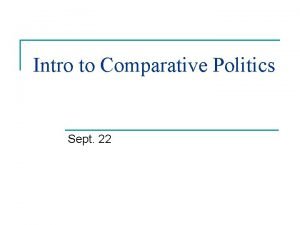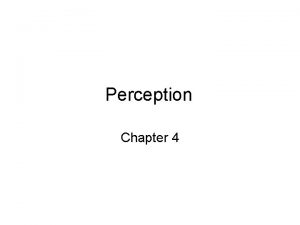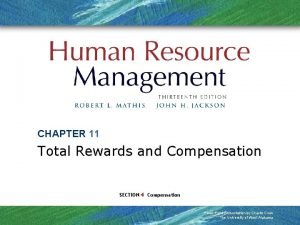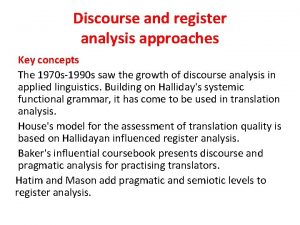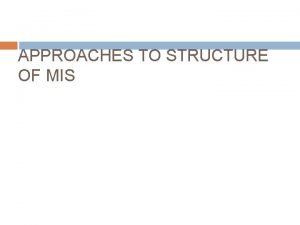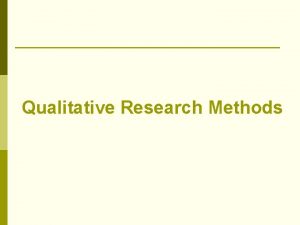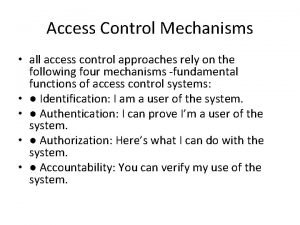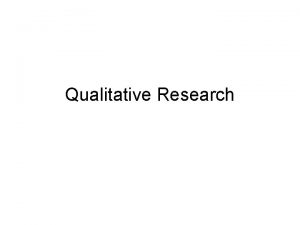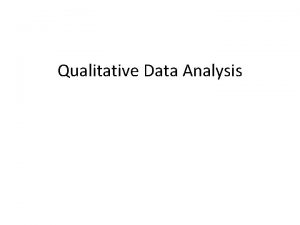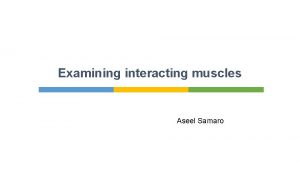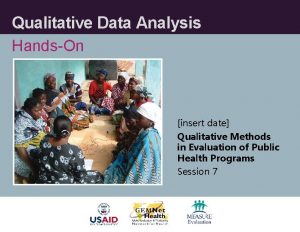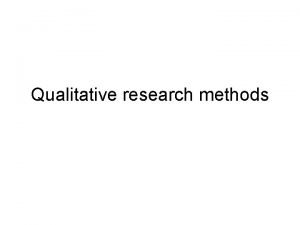Qualitative methods Examining approaches Qualitative Methods n Rely
















































- Slides: 48

Qualitative methods Examining approaches

Qualitative Methods n Rely on researcher as instrument n Introduces certain issues n Inherent subjectivity and bias n Consistency in data collection and interpretation n Impact of researcher on environment (esp. when studying people) n How do we control for reliability and validity?

Qualitative Methods

Interacting with people/environments QUALITATIVE METHODS

Case Study n In-depth review of a single situation: program, process, phenomenon n Might be descriptive or explanatory in approach n Might also form the basis of theory development, or modification of existing theories n Case studies are usually built on one or more of the following methods.

Qualitative Study: Observation n Attempt to understand activities/ behaviors n Role of the observer: n Complete participant n n Effects on the environment/process Genuine or not? § “Going native” n n n Present self as participant not researcher Ethical implications? Observer and participant n Effects on process?

Observation n Complete observer n n Lessen effect on environment (perhaps) Less likely to fully appreciate situations/contexts n Other choices n How much time/frequency on-site n Focus- comprehensive or narrow n Issues n Relations to subjects

Qualitative Study: Interviews n Attempt to gain in-depth knowledge on a topic n In a less structured format, interviewer may act more as facilitator, asking open ended questions and drawing the participant out. n Structured, semi-structured, or unstructured? n Format- in person, telephone, email?

Interviews n Types of questions: n Experience/ behavior n Feeling n Opinion/ value n Knowledge n Sensory n Demographic

Interviews n Issues n Logistics n Building trust n Delicate questions/ situations- ensuring honesty n Accuracy of transcripts n Advantages and disadvantages? n Appropriate uses?

Qualitative Study: Focus Groups n Attempt to learn about the attitudes/ beliefs/ feelings of groups and how those influence behavior n Why groups? One individual’s comments can trigger important responses from others. n Can explore large ranges of topics

Focus Groups n Issues n How structured? n Importance of facilitator’s role- how well trained? n Building trust n Finding reliable representative volunteers n Ensuring accuracy of transcription- audio/ video tape? Outside observation? n Facilities

Qualitative Study: Think-Aloud n Asks respondent to verbalize their thoughts while performing an assigned activity or task n Attempt to gain more insight into thought processes n Correct for mistakes/ assumptions of observer

Think Aloud n Requires participants that are highly verbal in nature n Adding this layer of feedback may affect their cognitive processes and behaviors- more “self -concious. ” n How to transcribe while observing? Accuracy? n Appropriate use of clarifying questions? n Appropriate uses?

Qualitative Study: Ethnographic n Tools developed in the field of cultural anthropology n Attempt to better understand people/ behavior by observing it within natural setting n Can study observable material items, individual behaviors and performances, or ideas n Requires careful attention to detail within cultural context

Ethnographic n Possible Tools: n Observation in context n Key informant interviewing n Drawing pictures n Taking photos n Using maps to track activities n Videotaping

Ethnographic: Examples n Susan Gibbons and Nancy Fried Foster of University of Rochester: Understanding Users to Develop Better Library Services (ACRL/NEC 2006) User-centered studies of library use… n Mapping Diaries n Photo Elicitation Interviews n

Photo Elicitation

Mapping Diaries

Qualitative Study: Delphi Method n A “systematic interactive forecasting method. ” n Involves interviewing/ surveying of experts within a field- generally 9 to 99 n Experts are provided with hypotheses, trigger statements, scenarios, etc. and asked to respond. n First round responses are shared with the group anonymously, so participants can revise earlier statements, react to responses.

Delphi Method n After several rounds, hypotheses may be refined, group may reach “consensus” n Facilitator reviews responses to each roundcan filter out irrelevant content, choose presentation of information, ask questions. n Advantages and disadvantages?

Interacting with Artifacts QUALITATIVE STUDIES

Types of Documents? n Policy Manuals n Digital reference transcripts n Comment/ complaint cards n Job ads n Published Literature n Blogs, listserv postings, etc. n Open-ended responses

Evaluation Research n Published n n n n n Books Journal articles Conference proceedings Theses/dissertations Web ALA. ACRL. CIP Notes CLIR. www. clir. org/pubs. html ARL Other n Peer Review n Unpublished n n Internal reports Local use only reports

Qualitative Analysis: Examining Documents n Focus on: n Word choice n Word frequency n Word sequence n Intensity of feeling/ expression (how to measure? ) n Key word in context n Typology of concepts/ categories?

Qualitative: Examining Documents n Systematic review of text/ images: content analysis n Classifies textual or visual material n Uses analytical constructs or rules to draw inferences about recurring aspects of text.

Qualitative Study: Diaries n Participants record activities, thoughts, reactions, etc. daily (weekly, etc. ) over a set period of time. n Blogs- equivalent? n When to use? n Issues n n n How faithful are participants? How can you help ensure full participation? How much guidance to give? Too much/ too little detail. n Advantages and disadvantages?

Examples n Nicole Henning/ Photo Diary Study (MIT) n 16 students tracked their information seeking behavior for one week. n Used diaries and screen shots to record their thoughts and actions n Hernon et. al. n Track library directors to identify leadership and management behaviors n Used diaries to record activities for two months

Grounded Theory n The attempt to derive theories from an analysis of patterns, themes, and common categories discovered in observational data. n Relies on a systematic set of procedures (i. e. systematic coding, reliability and validity)

Qualitative Study: Citation Analysis n Systematic review of bibliographies/ references within published literature. n Focus on Authorship n Form of publication (periodical, monograph, etc. ) n Class of material (primary, secondary, etc. ) n Language n Subject n Currency n

Citation Analysis n What can citations tell us? n How scholarly is the cited literature? n How current are the citations? n How research-oriented is it? n How interdisciplinary is it? n How writes the literature? How collaborative? n Where does the literature appear?

Citation Analysis n Growth of literature on a subject n Dispersion of writings on a subject across form and journals n Obsolescence of literature n Scholarly networks: who cites whom? n Publishing productivity

Citation Analysis n Advantages n Shows what is cited n Does not involve interaction with subjects n Profiles a literature n Shows changes in a field over time? n Disadvantages n How complete is the work from which citations are drawn? n How accurate are citations? n Are all materials cited? n Choosing easy to find/ retrieve items over better quality? n How easily retrievable are works?

Citation Analysis: Issues n From where are citations drawn? How far can you n n generalize findings? Does citation reflect use? Self-citations and/ or gratuitous citations Half-life Impact factor (to what extent are recent articles in journals cited? ) n Calculated annually: divide the number of current citations a journal receives to articles published in the previous two years by the number of articles published in those same years

Web Citations n How “prestigious” are different online sources- ejournals, open access, etc. n References to and from a Web site n Retrievability

Sweeping Studies n A type of spatial data analysis n Useful for mapping out the physical spaces of a library and investigating how people use those spaces


Qualitative Study: Concept Mapping n “Any process that represents ideas in pictures of maps. ” n A method of organizing the ideas and thoughts of a group to form a common framework n Can be used to integrate ideas from less structured activities such as brainstorming

Concept Mapping n Typical steps: n Focus: determine desired outcomes/ questions to be addressed n Generating ideas: Brainstorm, use trigger statements, ask questions n Analysis: Sort ideas into large sets n Unstructured idea sorting: ask individuals to sort ideas into groups and label n Sorting by stakeholders: organize ideas by group that generated those ideas n Ratings: assign values to ideas (importance, feasibility, etc. )

Concept Mapping n Map analysis: generate map based on idea sorting (could use statistical software, or do by hand) n Interpret map: Share with other groups to obtain understanding

Example: IR and IL

Collection and Analysis QUALITATIVE DATA

Qualitative Data n Systematic collection of data is important n Recording observations n Separating “fact” from feelings and impressions n Empirical observations and interpretation n Deep, thick description n Don’t rely on memory- record as much as possible n Take notes in stages

Qualitative Data n Validity n Field research tends to be more valid than experimental or survey measures. Why? n Reliability n Researcher is the tool- biases and assumptions can influence analysis n Helps to identify and acknowledge those biases and assumptions beforehand, be aware of them throughout

Qualitative Data Analysis n Interplay of theory and analysis- rechecking data against existing theories/modes of thinking n Discovering patterns: Frequencies n Magnitudes n Structures/Types n Processes n Causes n Consequences n

Qualitative Data Analysis n Grounded theory- generating theory solely from examination of data n Usually progresses in four stages (constant comparative method): Comparing incidents applicable to each category n Integrating categories and their properties n Delimiting theory n Writing theory n

Qualitative Data Coding n Coding- classifying or categorizing individual pieces of data Choosing a concepts to code n Physically coding- by hand or with software n Creating codes n Open coding- naming and categorizing phenomena through close analysis of the data. Categories arise from the data n

Qualitative Data Coding n Memoing- writing notes to yourself as you code data n n n Code notes- identify code meanings and labels Theoretical notes-reflections on meanings, relationships among concepts, theoretical propositions, etc. Operational notes- notes on methodological issues, data-collection circumstances, etc. Sorting memo- attempt to discover or create meaning in the data Integrating memo- ties it all together
 When should you use light cured gels
When should you use light cured gels To map earth's interior geologists
To map earth's interior geologists Rely af
Rely af Vliw processors rely on
Vliw processors rely on Rely
Rely F.r.o.g fully rely on god
F.r.o.g fully rely on god Rely on jehovah
Rely on jehovah Acquiring spiritual knowledge part 4
Acquiring spiritual knowledge part 4 Is sociology a social science
Is sociology a social science What conclusions can you make from examining the geochart?
What conclusions can you make from examining the geochart? Data preparing exploring examining and displaying
Data preparing exploring examining and displaying Examining social life
Examining social life Examining social life practice
Examining social life practice Two people can have identical handwriting.
Two people can have identical handwriting. Direct/expository instruction approach
Direct/expository instruction approach Integrating qualitative and quantitative methods
Integrating qualitative and quantitative methods Quantitative vs qualitative experiment
Quantitative vs qualitative experiment What is the sample size in qualitative research?
What is the sample size in qualitative research? Qualitative research methods
Qualitative research methods Qualitative research characteristics
Qualitative research characteristics Qualitative research methods
Qualitative research methods Sampling procedure in research
Sampling procedure in research Qualitative forecasting methods
Qualitative forecasting methods Visual methods in qualitative research
Visual methods in qualitative research Methodology
Methodology Qualitative research methods in political science
Qualitative research methods in political science Qualitative research methods
Qualitative research methods Inlay wax pattern fabrication
Inlay wax pattern fabrication Approaches to corporate governance
Approaches to corporate governance Gentle persuasive approaches (gpa) training
Gentle persuasive approaches (gpa) training Rogers humanistic theory
Rogers humanistic theory Accenture delivery suite line of business
Accenture delivery suite line of business Single species approaches to protecting biodiversity
Single species approaches to protecting biodiversity Contoh pendekatan hasil
Contoh pendekatan hasil Trends shaping hrm
Trends shaping hrm Ib approaches to teaching and learning ppt
Ib approaches to teaching and learning ppt Step wise project planning
Step wise project planning Political comparative and superlative
Political comparative and superlative Approaches to perception
Approaches to perception Compa ratio
Compa ratio Historical approach
Historical approach Trait theory of leadership
Trait theory of leadership What are two different region filling algorithms
What are two different region filling algorithms Marketing research approaches to demand estimation
Marketing research approaches to demand estimation Register in discourse analysis
Register in discourse analysis Approaches to formulation of accounting theory
Approaches to formulation of accounting theory Multiple approaches to the structure of mis
Multiple approaches to the structure of mis Substantivism vs formalism
Substantivism vs formalism Cost approaches and techniques in suppler assessment
Cost approaches and techniques in suppler assessment

